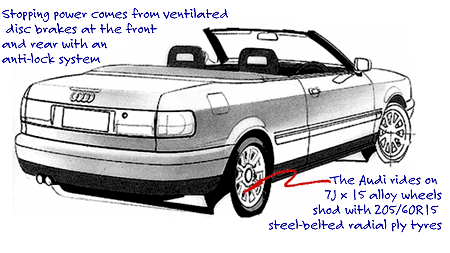BY MALCOLM LIVERMORE | 25th Sep 2003

Saab had just launched its new open-top version of the 900, Peugeot had lifted the lid on the 306 and Volkswagen was preparing to unveil its Golf Cabriolet at the Sydney motor show.
But the Audi convertible’s chief rival when it was launched in late 1993 was BMW’s newly released E36 325i soft-top.
Apart from its front-drive configuration, the Audi was seen by the local importer, TKM Automotive, as a direct competitor and was priced accordingly, within a few thousand dollars of its Munich counterpart.
Like BMW, Audi offered a fully automated top, driver’s side airbag, anti-lock brakes, leather trim, alloy wheels and air-conditioning as standard.
Over and above the BMW, it added a boot-mounted CD stacker and a touch of wood trim.
The Audi’s soft-top folds away at the press of a button and hides under a special panel behind the rear seat. The only part involving manual operation is the fastener at the top edge of the windscreen.
Many other little niceties seen in BMW convertibles are also found in the Audi, including one-touch side window operation and a special blower behind the rear seat for demisting the “polyglass” plastic rear window.
The Audi was also subjected to far reaching structural work aimed at regaining the strength lost with the removal of the roof.
Transmission is via an automatic only — Audi’s four-speed, electronically controlled box that offers the choice of “economy” or “sport” modes and features torque converter lock-up in third and fourth gears to help lower fuel consumption. The 2.6-litre engine was the lower echelon V6 to the 128kW, 2.8-litre version used in the larger Audi 100.
It lacks some of the bigger engine’s refinements — such as a dual length inlet manifold — but still produces a handy 225Nm of torque to complement the maximum power output of 110kW.
But it does have some extra weight to carry around in the cabriolet and the engine stands out more for its smoothness than accelerative ability.
Driving the cabriolet is more about revelling in the rush of air sweeping through the cockpit while enjoying panoramic views than exploring the outright performance or roadholding abilities.
Despite the work on strengthening the body, the Audi squirms on rough roads and tends to feel a little “loose” overall. The flex in the body also results in ponderous handling well below the 325i’s standard.
The Audi Cabriolet was never a huge sales success in Australia, partly due to its relatively high retail price of $86,990. Nevertheless, the car’s graceful lines and prestige appeal did make it a hit with some buyers.
Audis are generally well built cars with sound reliability records and the Cabriolet is no exception, even though its structural rigidity is not in the same league as its hardtop siblings.
When looking to buy an Audi Cabrio ensure the roof folding mechanism works properly, listen for excessive wind noise at cruising speeds — possibly a sign of an improperly sealing top — and even ask to hose the roof down.